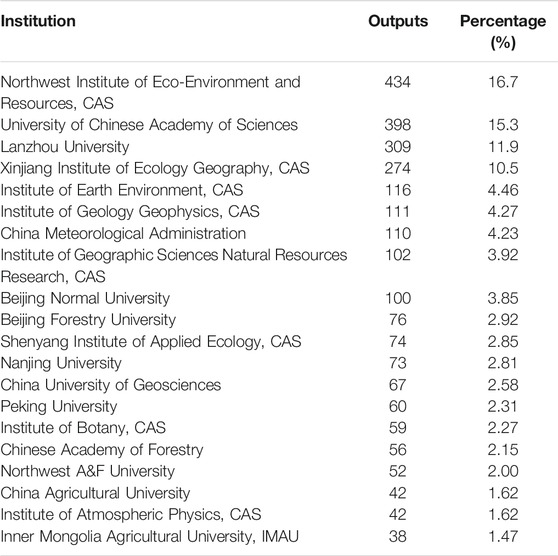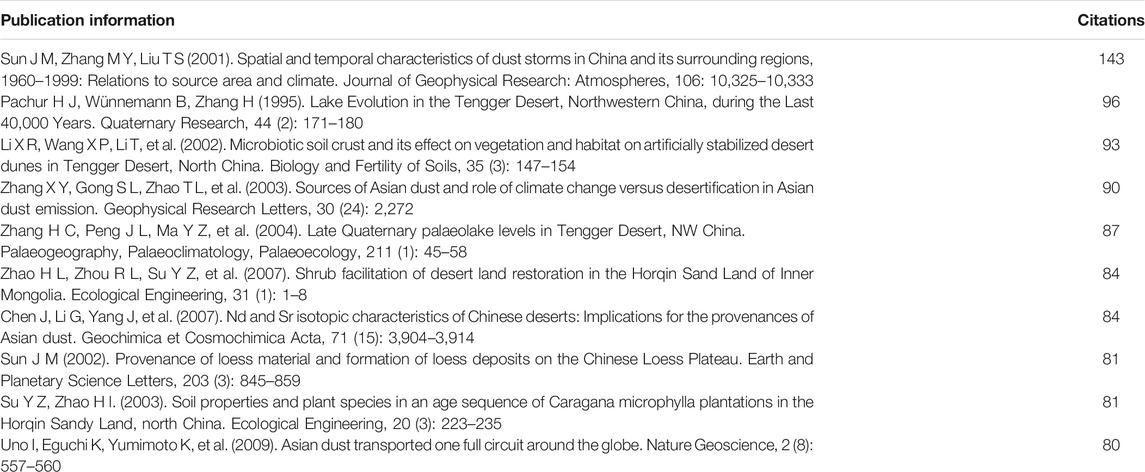- 1Shapotou Desert Research and Experiment Station, Northwest Institute of Eco-Environment and Resources, Chinese Academy of Sciences, Lanzhou, China
- 2University of Chinese Academy of Sciences, Beijing, China
- 3Gansu Meteorological Information and Technology Support Center, Gansu Meteorological Bureau, Lanzhou, China
- 4College of Agronomy and Biotechnology, China Agricultural University, Beijing, China
- 5Northwest Institute of Eco-Environment and Resources, Chinese Academy of Sciences, Lanzhou, China
- 6Jiangsu Key Laboratory of Crop Genetics and Physiology/Jiangsu Key Laboratory of Crop Cultivation and Physiology, Agricultural College of Yangzhou University, Yangzhou, China
With the economic progress and scientific development since the 1980s, research on deserts in China has advanced remarkably. Many research outputs have been published, especially in recent years. However, a systematic review and quantitative analysis of these publications has been lacking. Here, we conducted a comprehensive bibliometric analysis of the main deserts in China in order to characterize the trends and temporal changes in publications. Because the first publication was found in 1986, we searched all publications from 1986 to 2020. We found that annual publication output increased exponentially, especially after 2012, and that the Tengger Desert, the Taklimakan Desert, and the Horqin Sandy Land were the most intensively studied areas. Earth science, involving environmental science and ecology, geology, and agriculture were the major research fields. In addition, Journal of Arid Land, Chinese Science Bulletin, and Catena were the journals with the largest number of publications. The Chinese Academy of Sciences produced the largest number of publications, wherein, Li X R, Zhao X Y, and Zhang Y M were the three most productive authors. Noticeably, “climate change” has become a frequent topic since 2010, indicating that more attention has been paid to climate change and alleviating anthropogenic disturbances in desert areas in China. Although Chinese authors contributed the most publications, the average number of citations per publication for Chinese authors was relatively low. Our results highlight that authors should continue to improve the number of citations of their publications and pay more attention to the interactions between climate change and desertification in the deserts research of Northern China in the futures.
Introduction
Due to economic development and governmental support, research on deserts in China has made tremendous progress over the past 30 years (Wang, 2009; Li et al., 2017). As one of the largest sandy regions in the world, desert lands in Northwestern China cover approximately 1,721,200 km2 and account for 17.93% of China’s total area (State Forestry Administration, 2015). Characterized by severe sandstorms and extreme water shortage, Northwestern China has encountered serious ecological and environmental stresses, such as the increasing desertification and frequent sand and dust storms (Zhu, 1985). Since the 1950s, the Chinese government has promoted a series engineering solutions to stabilize sands, such as the protective system of the Shapotou section of the Baotou-Lanzhou Railway (Li et al., 2017) and the Three-North Shelter Forest Program (Bao et al., 2018). At that time, the main goal of research on deserts in China was to provide guidance and suggestions for sand-stabilization engineering (Wang et al., 1999). It was only after China’s reform and opening up in the 1980s that scientific research and publications have become a focus of this research field (Wang et al., 1999; Li et al., 2017). In addition, increased exchange and cooperation with other countries has prompted relevant institutions and researchers to publish in international journals (Wang et al., 1999).
Due to continuous efforts, the environmental and ecological issues in desert areas in Northern China have been significantly mitigated in recent years (Chen et al., 2019). At the same time, global change has emerged as a hotly debated topic across the world in the past 2 decades (Puigdefábregas, 1998; Franklin et al., 2016). It also may be a major disturbance to deserts that should be considered in research on deserts in Northern China (Yang et al., 2021). Therefore, research on deserts in China has entered a new stage, and a systematic review at this time could provide meaningful insight into future work for this research field (Shi et al., 2007; Yang et al., 2021). Although there have been a few reviews on this topic, such as Wang, (2009), none has included research from the most recent 10 years. Moreover, most reviews were narrative and qualitive, and lacked quantitative analysis using modern bibliometric methods.
The conditional qualitative reviews are narrative and suffer from some important limitations. One is the subjectivity and the lack of transparency inherent in this approach. A second limitation of narrative reviews is that they become less useful as more information becomes available, especially in a time with information explosion (Wallin, 2005). As the progress of computer technology, quantitative reviews represented by bibliometric analysis has become a powerful tool to conduct systematic and transparent reviews of a specific research field by processing a large number of publications (Borgman and Rice, 1992; Bornmann and Mutz, 2015). This methodology provides detailed information on the annual outputs, temporal evaluation of key words, dominant research areas, marked journals, and the institutions and authors involved in the research (Wallin, 2005; Aria and Cuccurullo, 2017). Bibliometric analysis also provides ways of exploring the potential relationships between publications and can reveal emerging trends in research (Liu et al., 2011; Michael Hall, 2011). The major differences between bibliometric analysis and traditional narrative review are that bibliometric analysis is more quantitative and less subjective (Bornmann and Mutz, 2015). In an era of information explosion and dramatic increase of publications (Michels and Schmoch, 2012; Pautasso, 2012), bibliometric analysis is becoming more and more important for drawing systematic conclusions (Wallin, 2005; Neff and Corley, 2009; Zhang and Chen, 2020). Bibliometric analysis of the advancement of a particular field of scientific research is also called “the science of science” (Zhang and Chen, 2020).
To review the entire landscape, understand the development progress and predict its future research trends of the scientific research on deserts in China, we conducted a comprehensive bibliometric analysis on publications and citations. Specifically, we ask the following three questions: 1) What are the characteristics and patterns in desert research in China in the past 30 years? 2) What is the temporal evolution of research areas and topics? 3) What are the strategies for future work in this research field?
Data Collection and Analysis
Data Collection
We conducted a bibliometric collection on 20 May 2021 using topic search (TS) based on the Science Citation Index Expanded (SCI-E) database in “Web of Science Core Collection.” We selected SCI-E database because it provides comprehensive coverage of the most important and influential research outputs across the world.
We selected the eight main deserts and four so-called sandy lands in China as our search terms (See details Figure 1). These twelve deserts are ordered as followings: the Taklimakan Desert, the Gurbantunggut Desert, the Badain Jaran Desert, the Tengger Desert, the Kumtag Desert, the Qaidam Desert, the Kubuqi Desert, the Ulan Buh Desert, the Mu Us Sandy Land, the Hunshandake Sandy Land, the Horqin Sandy Land and the Hulunbuir Sandy Land. Hence, we retrieved the following outputs in detail: TS = [Taklimakan or Gurbantunggut or “Badain Jaran” or Tengger or Kumtag or (Qaidam and Desert) or (Hobq or Kubuqi) or “Ulan Buh” or (“Mu Us” and Desert) or (Hunshandake or Otindag) or Horqin or ((Hulunbuir or “Hulun Buir”) and (Desert or “Sandy land”))]. Because deserts are not distributed in all parts of some target areas, such as in the Qaidam Basin and the Hulunbuir grassland, we had to constraint our search strings to “desert” or “sandy land.” The document types in our research included articles, books, reviews and letters, but we did not include meeting abstracts, book reviews, and corrections.
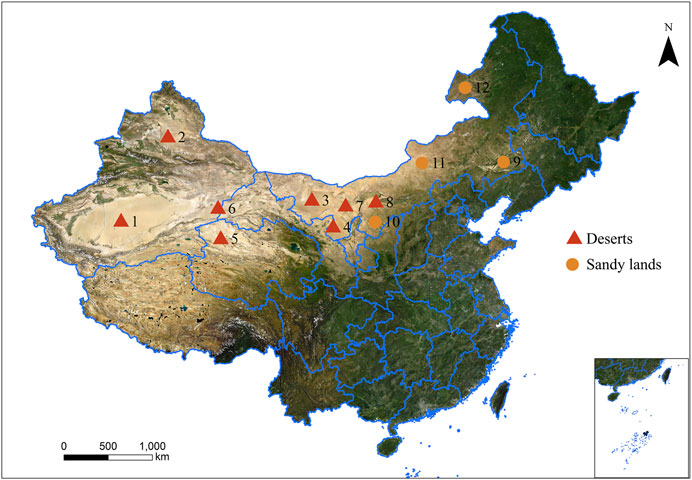
FIGURE 1. Geographic distribution of the main deserts (including eight deserts and four so-called sandy lands) in Northern China which were selected as search terms in the bibliometric analysis. 1: the Taklimakan Desert; 2: the Gurbantunggut Desert; 3: the Badain Jaran Desert; 4: the Tengger Desert; 5: the Qaidam Desert; 6: the Kumtag Desert; 7: the Ulan Buh Desert; 8: the Kubuqi Desert; 9: the Horqin Sandy Land; 10: the Mu Us Sandy Land; 11: the Otindag Sandy Land; 12: the Hulunbuir Sandy land.
The earliest study in the SCI-E database was from 1986, and thus we searched all publications between 1986 and 2020. A total of 2,600 documents were identified, and the three most productive research regions were the Tengger Desert (597 documents), the Taklimakan Desert (590 documents), and the Horqin Sandy Land (499 documents) (Figure 2A). However, less publications were founded for the Kubuqi Desert, the Ulan Buh Desert, the Hulunbuir Sandy Land, and the Kumtag Desert. The annual outputs for the Taklimakan Desert had significant increase after 2006, and the annual outputs for the Tengger Desert and the Horqin Sandy Land increased quickly from 2012 (Figure 2B). The most common publication type was research article, which accounted for 98.5% of the total outputs, and the remaining publications types included reviews (1.33%) and letters (0.1%).
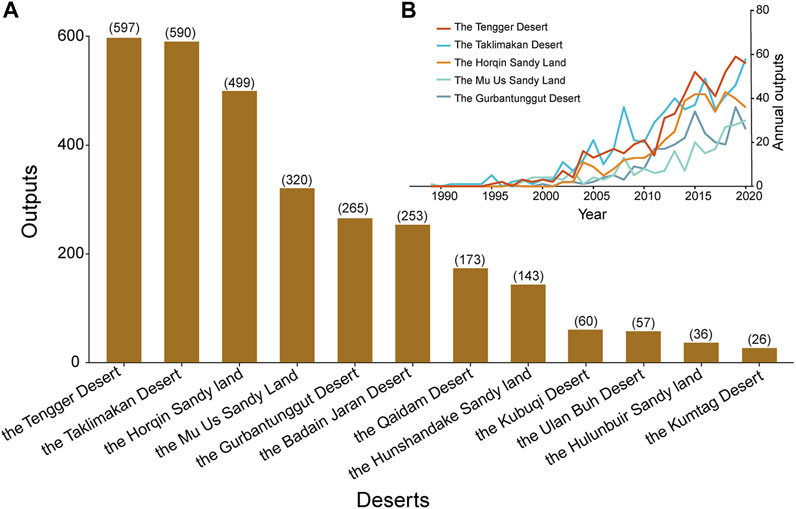
FIGURE 2. Outputs published for the main deserts in China from 1986 to 2020 on the SCI-E database. (A) Total outputs for the 12 main deserts. The outputs numbers are listed in parentheses. (B) Annual outputs for the five most productive deserts.
Data Analysis
To evaluate the research on deserts in China since 1986, we conducted our bibliometric analysis in the following five components: temporal evolution of annual outputs, main research areas, temporal evolution of keywords, marked journals, dominant institutions, and most productive authors.
Outputs and citations are the two main metrics that represent publication quantity and quality, respectively. Average number citations per output was used to show the average numbers for one paper cited by others in the local database (Zhang and Chen, 2020). To identify the most productive countries, we classified outputs by the nationality of their corresponding authors. International cooperation rate (ICR) for publications was measured as the proportion of papers whose authors come from at least two countries and was used to describe the cooperation patterns of one country with other countries (Bouabid et al., 2016). In addition, a concept map based on correspondence analysis in bibliometrics was used to show the clusters of research topics (Cuccurullo et al., 2016). Marked journals was assigned by the number of publications they carried on the subject based on Bradford’s law for bibliometric analysis (Gong et al., 2019).
We used the bibliometrix R package (Aria and Cuccurullo, 2017) to perform data mining and analysis. This package provides powerful and comprehensive tools for bibliometric analysis and has been widely used (Rodríguez-Soler et al., 2020; Niknejad et al., 2021). We used the ggplot2 R package (Wickham, 2016) to visualize the results.
Results and Discussion
Temporal Evolution of Annual Publications
After the first publication in SCI-E database in 1986, the annual output of research on deserts in China increased exponentially (Figure 3) with an average annual growth rate of 9.45%. Specifically, we divided the annual output into three rising periods: 1) ready-to-grow period: steady with slight rising from 1986 to 2000 with 58 publications totally; 2) steady growth period: publications were risen to 563 during 2001–2010, with an average annual growth rate of 87%; 3) explosive growth period: there were 1,957 publications from 2011 to 2020, with nearly 200 papers published per year. The remarkable growth occurred after 2012, during which time 71.8% of the total outputs were published. This dramatic increase followed the global trend of increasing academic publications in recent years (Mu et al., 2016; Zia, 2021). At the same time, it coincided with the remarkable growth of scientific research in China in the past 10 years. For example, Zhang and Chen (2020) found that almost 90% of the outputs about the Chinese Loess Plateau were published between 2006 and 2018. Dong et al. (2020) concluded that more than 40% of all publications about the Qinghai-Tibetan Plateau were published between 2013 and 2018. Therefore, the most likely explanation for this explosive increase in research output on deserts in China is due to the rapid economic development and increased support (e.g., more funding) from the Chinese government for scientific research (Dong et al., 2020). At the same time, it indicated that more attention have been paid to the environmental and ecological research on desert areas in Northern China. From this trend, it can be predicted that the annual publications of the research on deserts in China will continuous to increases in the next few years.
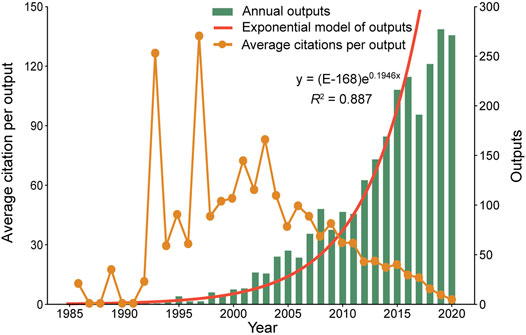
FIGURE 3. Annual outputs and average citations per output of the research on deserts in China from 1986 to 2020 in the SCI-E database. The red line is the predicted exponential model of annual outputs.
In contrast to the continuous growth in annual output, the average citations per output showed a fluctuant trend (Figure 3). The similar increasing trend for the average citations per output to the annual outputs were found during 1985–2003. This might be explained that researchers started to pay more attention to scientific research on deserts in this period, leading to a synchronous growth between outputs and citations under the circumstance that a relative small number of publications exists. The remarkable decrease in citations occurred after 2004, whereas annual production of publications increased rapidly during this period. One reason for the declining citation rate despite the increasing publication rate is that researchers had too abundant references to cite. Due to lags in publishing time, later outputs usually had lower citations while older outputs gradually lose their influence as they are replaced by more recent publications (Zhang and Chen, 2020). Therefore, what should be noted is that our analysis showed only the current citations of newly published papers and could not show their peak number of citations. Altogether, because of the continuing growth of outputs in desert research in China, it’s not surprising that the average number of citations per output decreased gradually.
Dominant Research Areas
Analysis of research areas can help to reveal the core subjects responsible for increasing productivity in the research field (Zhang and Chen, 2020). By analyzing the contents using Clarivate Analytics in Web of Science, each publication can be assigned to at least one research area. Based on the classification of the Web of Science research areas, the total number of research areas increased from 9 in 2000 to 32 in 2020. The 10 most productive areas were environmental sciences and ecology (accounting for 35.5%), geology (28.8%), agriculture (13.2%), physical geography (12.5%), soil science (12.5%), water resources (10.7%), meteorology and atmospheric science (10.6%), plant science (7.15%), engineering (4.31%), and geochemistry geophysics (3.85%) (Figure 4). This reveals that the research on deserts on China were mainly focused on earth sciences, although they covered a wide range of other research areas such as paleontology, energy fuels, business economics, nutrition dietetics, remote sensing, and archaeology. Some of the research of China’s deserts in the area of energy fuels concerned resource exploitation and petrochemical industry (Wang et al., 2008); business economics area involved the trade of livestock and Chinese herbal medicine (Song et al., 2021); remote sensing area regraded the use of geographic information system, remote sensing and machine learning method to evaluate and regulate the environment in the desert lands in Northern China (Xu et al., 2011; Filonchyk et al., 2018).
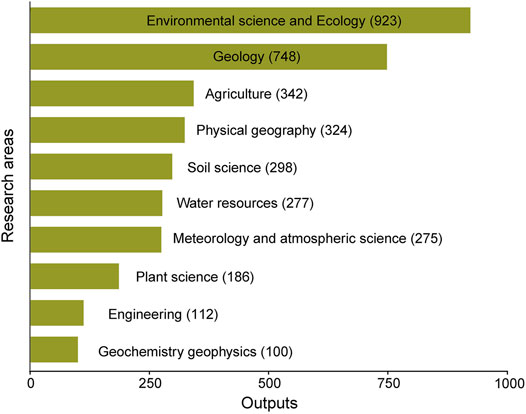
FIGURE 4. The 10 most productive areas of the research on deserts in China. The output numbers are listed in parentheses.
Due to limitations of water and nutrients availability and the scare of vegetation, desert lands are considered as one of the most ecologically fragile regions in the world. Hence, environment and ecology is usually an important focus for scientific research in this field (Wang et al., 1999; Li et al., 2018). It was confirmed by our results that the research area of environmental sciences and ecology accounting for 35.5% of the total publications for the research on deserts in China. Ecological restoration and environmental protection have always been important tasks in the regulation of desert areas in Northwestern China (Wang, 2009; Li et al., 2017). Meanwhile, ecological engineering construction in Northwestern China in the past 30 years has also driven a substantial amount of scientific research (Li et al., 2009; Chen et al., 2019). For example, based on the protective system of the Shapotou section of the Baotou-Lanzhou Railway, researchers analyzed the soil water carrying capacity of vegetation and the model for sand fixation by revegetation in aeolian desert areas where precipitation levels are less than 200 mm (Li et al., 2014). In addition, the research of the engineering practices for ecological restoration in the Horqin Sandy Land identified and parameterized various ecological models and techniques for the ecological restoration of desertified grassland (Zuo et al., 2012; Miao et al., 2015). Vice verse, research work in these areas could provide a scientific basis for decision-making by the government to formulate restoration policies, and technical guidance for the ecological restoration industry (Wang et al., 1999).
Temporal Evaluation of Frequent Keywords and Topic Clusters
Frequent keywords analysis can provide vital information about research trends and reveal new research directions (Xie et al., 2008; Sun et al., 2012; Zhang and Chen, 2020). Besides our search terms (e.g., Taklimakan Desert, Tengger Desert, Horqin Sandy Land, Badain Jaran Desert etc.), the most frequent keywords were related to “sand” and “soil,” including “sandy land,” “sand dunes,” “soil properties,” and “soil organic carbon,” with the frequencies of 623, 424, 222 and 206, respectively (Figure 5). At the same time, “water” was another frequent keyword and was associated with “soil moisture,” “soil water,” and “semi arid,” with the frequencies of 481, 473 and 290, respectively. These results indicated that construction projects aimed to stabilize sand dunes and improve soil and water conditions are still a major focus of research on China’s deserts (Su and Zhao, 2003; Li et al., 2007; Zou et al., 2010; Zhang and Zhao, 2015). In addition to these terms, “biological soil crusts” was also a frequent keyword with a frequency of 275. As a key biotic component of desert ecosystems, biological soil crusts can help maintain soil stability, influence soil hydrological processes, fix carbon and nitrogen, and promote the establishment of vascular plants and microorganism communities (Zhang et al., 2007; Li et al., 2010; Colica et al., 2014). The role of biological soil crusts in desert lands has been recognized and highly valued in recent years (Li et al., 2018), and even artificial crusts have been developed and applied to stabilize sandy dunes and in ecological restoration of arid and semi-arid ecosystems (Bu et al., 2017; Zhao et al., 2021).
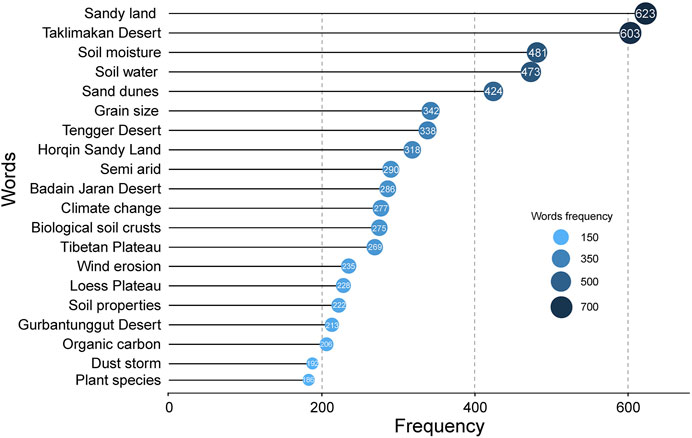
FIGURE 5. The 20 most frequent keywords from 1986 to 2020. Word frequencies are listed in parentheses.
Compared to the period of 1986–2010, the frequent keywords showed several changes during 2011–2020 (Table 1). The rank of “sand dunes” fell to sixth in period of 2011–2020 from the third during 1986–2010, despite that the frequency increased from 117 to 307. We also found the “dust storm” disappeared from the 15 most frequent keywords list in the period of 2011–2020. The above findings likely reflect that the mitigation of environmental issues resulted by Chinese government’s great efforts such as the Three-North Shelter Forest Program (Wang et al., 1999; Bao et al., 2018; Chen et al., 2019). However, with the global warming intensification, we found that the keyword “climate change” ranked into the top 10 with the frequency up to 242 between 2011 and 2020 (Table 1). The widespread focus on climate change in this research field was confirmed by the concept map of topics shown in Figure 6. The total research outputs can be clustered into three main topics, with the largest cluster focusing on “desert” and “desertification” and the other two clusters focusing on “water” and “climate,” respectively. These results indicated that more attention has been paid to the potential impacts of climate change on desert areas in Northern China (Shi et al., 2007; Dong et al., 2014; Zeng et al., 2016). For example, the climate transition from warm-dry to warm-wet in Northwestern China has been hotly debated in recent years (Yang et al., 2021). Altogether, climate change, combined with desertification, will remain an important research topic relevant to deserts in China.
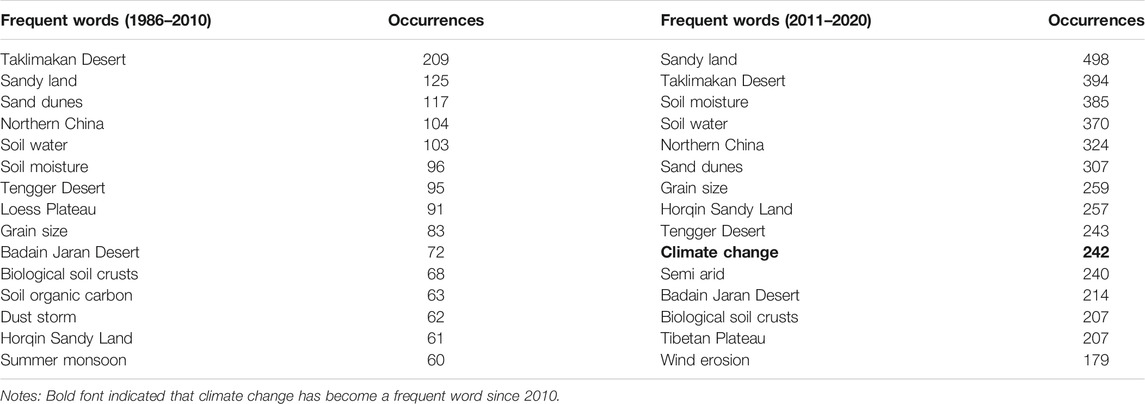
TABLE 1. The 15 most frequent words within two main time periods (i.e., 1986 to 2010 and 2011–2020).

FIGURE 6. The concept map for the research on deserts in China based on correspondence analysis. Each color represents a cluster of words (i.e., a topic).
In addition, it should be noted that the “Tibetan Plateau” became one of the 15 most frequent keywords in the period of 2011–2020 with more than two hundreds frequencies. As the “third pole of the world,” the Tibetan Plateau distributes alpine meadow and other kinds of grasslands, but why here became to a hot area relating to desert research? We explained this by that the land degradation and even desertification has been occurring in the Tibetan Plateau especially the region near the Qaidam Basin because of the grassland conversion to croplands, overgrazing, global warming and so on (Cao et al., 2004; Huang et al., 2020).
Marked Journals
The number of journals covering desert research on China has also increased significantly, and more journals were involving in this field. Before 2000, publications were founded in only 45 journals, and the total research outputs have been published in 482 journals now. Based on Bradford’s law of bibliometrics (Pope, 1975), the 18 most productive journals were assigned to the core class (Table 2). These journals published 880 (33.8%) of the total 2,600 papers. The five most productive journals were Journal of Arid Land (109 papers), Chinese Science Bulletin (74 papers), Catena (64 papers), Environmental Earth Sciences (59 papers), and Journal of Arid Environment (56 papers). As the most productive journal, Journal of Arid Land has exhibited the fastest increase since its establishment in 2009 (Figure 7). Meanwhile, Chinese Science Bulletin, as a classical journal in this research field, showed almost no increase after changed the journal title changed to Science Bulletin in 2015. Overall, the publications in these marked journals displayed a similarly dramatic increasing trend with the annual outputs showed in Figure 3.
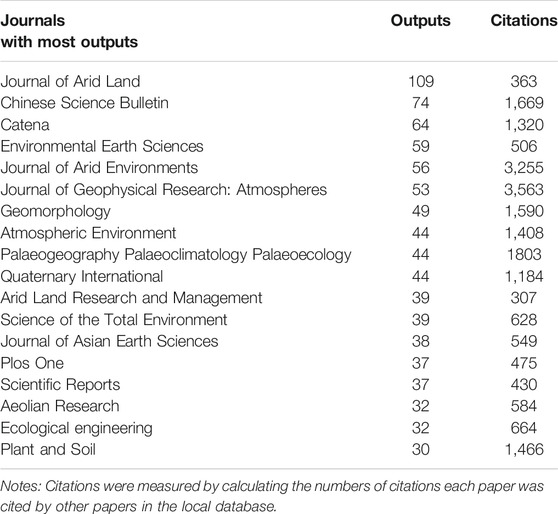
TABLE 2. The 18 core journals publishing work on China’s deserts classified by Bradford’s law and their corresponding output numbers and citations.
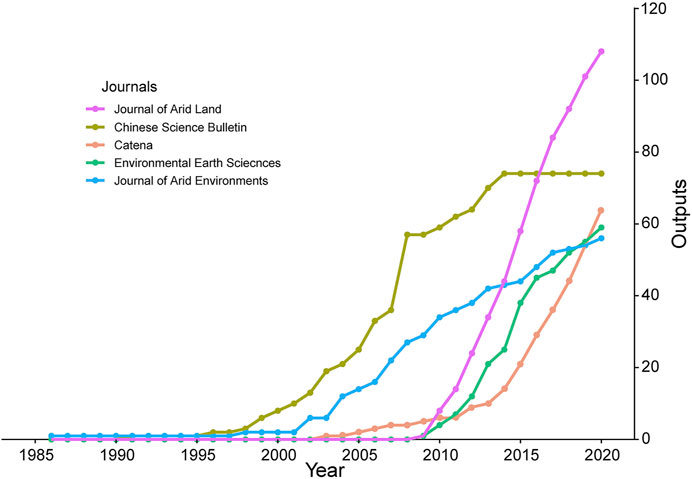
FIGURE 7. The temporal trend of the top five most productive journals that published papers on China’s deserts.
The top three journals with the highest citations were Journal of Geophysical Research: Atmospheres, Journal of Arid Environments, and Palaeogeography Palaeoclimatology Palaeoecology. Although Journal of Arid Land had the largest number of publications, it did not have the highest number of citations. The most likely reason is that papers in Journal of Arid Land were mainly published only recently (after 2009), and it takes time for newly published papers to be cited. In summary, the scope of the most productive journals covering desert research on China are about earth science in arid land, involving environmental and ecological management, land degradation and restoration process, ecosystem health and sustainable development, and environmental change.
Dominant Institutions and Competitive Authors
All of the outputs were distributed in 43 countries, and most studies were conducted by Chinese authors (2,198 outputs; 84.6%) (Table 3). The other four most productive countries were Japan (4.73%), the United States (3.19%), Germany (1.39%) and the United Kingdom (1.00%). As the deserts are located in China, it’s not uncommon that the international cooperation rate for Chinese authors was relatively low (ICR = 0.263; Table 3), ranking ninth among the top 10 most productive countries. Despite Chinese authors accounted for the most of outputs, the average number of citations per output for Chinese authors was low (18.02), ranking only eighth among the top 10 countries with the highest number of citations (Table 4). The average number of citations to a certain extent could represent the overall research quality and the global influence for a specific field (Mu et al., 2016; Zhang and Chen, 2020). Hence, these results highlight that Chinese researchers should improve the average number of citations of their outputs to expand their global influence.
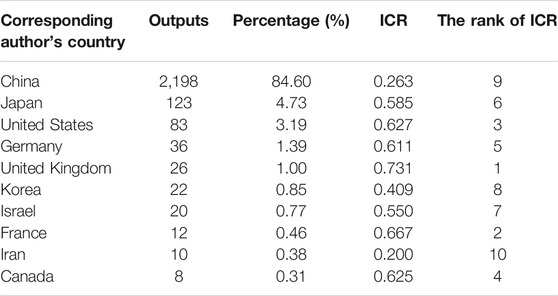
TABLE 3. The 10 most productive countries and their corresponding international cooperation rate (ICR), as measured by publications.

TABLE 4. The top 10 countries whose outputs had the largest number of citations and their corresponding average number of citations per output.
According to our analysis, 1,653 institutions worldwide have engaged in research on Chinese deserts, and the top 20 most productive institutions contributed 2,595 papers (including collaborative publications). The Chinese Academy of Sciences (CAS) accounted for the largest number of papers (1,477 papers; 56.8%) (Table 5). Specifically, Northwest Institute of Eco-Environment and Resources (NIEER, CAS), University of Chinese Academy of Sciences (UCAS), Lanzhou University, and Xinjiang Institute of Ecology Geography (XIEG, CAS) had significantly more publications than other institutions. Most of the dominant institutions were located in the Northwestern region of China.
The analysis of authors revealed the researchers who had more outputs and made important contributions. There were 5,373 authors in total, of whom 3,283 (61.1%) had published only one paper. The 10 most productive authors were all from China and contributed a total of 601 papers (23.1%) (Table 6). Li X R, Zhao X Y, and Zhang Y M were the top three most productive authors, and Li X R, Wang X P, and Yang X P were the authors with the highest number of citations. Therefore, Li X R was the author with both the highest number of publications and citations. In addition, we found that the 10 most highly cited papers in this research work were all published before 2010 (Table 7). The citation numbers is usually an important indicator to evaluate the quality of publications (Zhang and Chen, 2020). However, the continuous increase of annul publications in the recent 10 years has resulted in the decline of citations per publication even for the high-quality papers. Therefore, we should take a more rational view to recognize and assess the citation numbers of publications today.
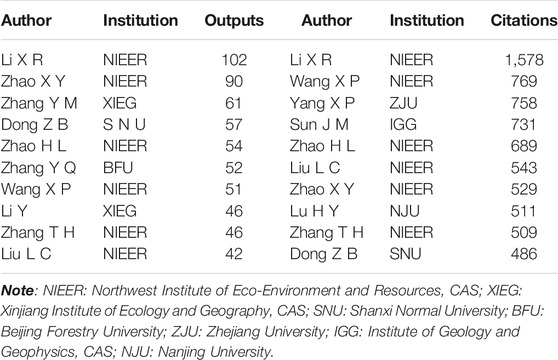
TABLE 6. The 10 most productive authors and the 10 most highly cited authors for research on China’s deserts.
Conclusion
Using a bibliometric method, our study was the first to analyze the publications of the research done on deserts in China over the past 30 years. It provided a qualitive and quantitative overview of the past work in this field, and highlighted the future prospects. The results showed that the three desert lands that were the most studied were the Tengger Desert, the Taklimakan Desert, and the Horqin Sandy Land. The number of publications produced annually increased exponentially, especially after 2012. This growth coincided with the general trend in science across the world and in China. In addition, we predict that the number of annual publications will continuous to increase in the next several years.
The research areas of the research on deserts in China are multidisciplinary and focused mainly on earth science, including environmental science and ecology, geology, agriculture, physical geography, soil science, and engineering. Frequent keywords analysis showed that the core topics in this research field included “desertification,” “water” and “climate.” Climate change has become a major focused since 2010. Traditional the research work of deserts in China focused on desertification and sand-stabilization engineering. However, it has crossed the boundaries and started to be combined with climate change in the past 10 years. It showed that the current main task of the desert research in China is changing to alleviate anthropogenic disturbances and promoting sustainable development.
The three most productive journals were Journal of Arid Land, Chinese Science Bulletin, and Catena. Although its establishment was late, Journal of Arid Land has exhibited the fastest increase in the past 10 years and becomes the most productive journals. Northwest Institute of Eco-Environment and Resources (NIEER, CAS), University of Chinese Academy of Sciences (UCAS), Lanzhou University, and Xinjiang Institute of Ecology Geography (XIEG, CAS) contributed larger number of publications than other institutions. Most of these dominant institutions were located in the Northwest region of China. Li X R, Zhao X Y, and Zhang Y M were the three most productive authors, and Li X R, Wang X P, and Yang X P were the authors with the highest number of citations. Although contributed to the most papers (84.6%), the average citations for Chinese authors was relatively low.
As our analysis was based on the SCI-E database in Web of Science, some outputs published in Chinese are not included. Although additional publications in other databases could be supplemented, it could cause a bias regarding other languages. In conclusion, this research provided a new view for the elucidation of the evolution of the research on deserts in China, and developed insights for future work in this filed.
Data Availability Statement
The original contributions presented in the study are included in the article; further inquiries can be directed to the corresponding author.
Author Contributions
Conceptualization, Y-SJ and X-MH; methodology, Y-FS; formal analysis, Y-FS, S-HS, Y-SJ, and X-MH; data curation, Y-FS; writing-original draft preparation, Y-FS and X-MH; writing-review and editing, Y-FS, F-FH, S-HS,Y-SJ, and X-MH; visualization, Y-FS. All authors have read and agreed to the published version of the manuscript.
Funding
This work was supported by the National Key R&D Program of China (2020YFA060840X).
Conflict of Interest
The authors declare that the research was conducted in the absence of any commercial or financial relationships that could be construed as a potential conflict of interest.
Publisher’s Note
All claims expressed in this article are solely those of the authors and do not necessarily represent those of their affiliated organizations, or those of the publisher, the editors and the reviewers. Any product that may be evaluated in this article, or claim that may be made by its manufacturer, is not guaranteed or endorsed by the publisher.
Acknowledgments
We would like to thank Prof. Adam Roddy at Yale University for his assistance with English language and grammatical editing.
References
Aria, M., and Cuccurullo, C. (2017). Bibliometrix : An R-Tool for Comprehensive Science Mapping Analysis. J. Informetrics 11, 959–975. doi:10.1016/j.joi.2017.08.007
Bao, Y. F., Yang, L., Long, C., Kong, Z., Peng, P., Xiao, J., et al. (2018). Review of 60 Years Combating Desertification in China and Prospects on it. Sci. Soil Water Conserv. 16, 144–150. doi:10.16843/j.sswc.2018.02.019
Borgman, C. L., and Rice, R. E. (1992). The Convergence of Information Science and Communication: A Bibliometric Analysis. J. Am. Soc. Inf. Sci. 43, 397–411. doi:10.1002/(sici)1097-4571(199207)43:6<397:aid-asi1>3.0.co;2-m
Bornmann, L., and Mutz, R. (2015). Growth Rates of Modern Science: A Bibliometric Analysis Based on the Number of Publications and Cited References. J. Assn Inf. Sci. Tec. 66, 2215–2222. doi:10.1002/asi.23329
Bouabid, H., Paul-Hus, A., and Larivière, V. (2016). Scientific Collaboration and High-Technology Exchanges Among BRICS and G-7 Countries. Scientometrics 106, 873–899. doi:10.1007/s11192-015-1806-0
Bu, C., Wang, C., Yang, Y., Zhang, L., and Bowker, M. A. (2017). Physiological Responses of Artificial moss Biocrusts to Dehydration-Rehydration Process and Heat Stress on the Loess Plateau, China. J. Arid Land 9, 419–431. doi:10.1007/s40333-017-0057-8
Cao, G., Tang, Y., Mo, W., Wang, Y., Li, Y., and Zhao, X. (2004). Grazing Intensity Alters Soil Respiration in an alpine Meadow on the Tibetan Plateau. Soil Biol. Biochem. 36, 237–243. doi:10.1016/j.soilbio.2003.09.010
Chen, C., Park, T., Wang, X., Piao, S., Xu, B., Chaturvedi, R. K., et al. (2019). China and India lead in Greening of the World through Land-Use Management. Nat. Sustain. 2, 122–129. doi:10.1038/s41893-019-0220-7
Colica, G., Li, H., Rossi, F., Li, D., Liu, Y., and De Philippis, R. (2014). Microbial Secreted Exopolysaccharides Affect the Hydrological Behavior of Induced Biological Soil Crusts in Desert sandy Soils. Soil Biol. Biochem. 68, 62–70. doi:10.1016/j.soilbio.2013.09.017
Cuccurullo, C., Aria, M., and Sarto, F. (2016). Foundations and Trends in Performance Management. A Twenty-Five Years Bibliometric Analysis in Business and Public Administration Domains. Scientometrics 108, 595–611. doi:10.1007/s11192-016-1948-8
Dong, L., Li, Z. X., and Wei, R. (2020). A Bibliometric Analysis of International Research on Tibetan Plateau, 1981-2018. World Sci-Tech R&D 42, 412–415.
Dong, W., Cui, B., Liu, Z., and Zhang, K. (2014). Relative Effects of Human Activities and Climate Change on the River Runoff in an Arid basin in Northwest China. Hydrol. Process. 28, 4854–4864. doi:10.1002/hyp.9982
Filonchyk, M., Yan, H., Yang, S., and Lu, X. (2018). Detection of Aerosol Pollution Sources during Sandstorms in Northwestern China Using Remote Sensed and Model Simulated Data. Adv. Space Res. 61, 1035–1046. doi:10.1016/j.asr.2017.11.037
Franklin, J., Serra-Diaz, J. M., Syphard, A. D., and Regan, H. M. (2016). Global Change and Terrestrial Plant Community Dynamics. Proc. Natl. Acad. Sci. USA 113, 3725–3734. doi:10.1073/pnas.1519911113
Gong, R., Xue, J., Zhao, L., Zolotova, O., Ji, X., and Xu, Y. (2019). A Bibliometric Analysis of green Supply Chain Management Based on the Web of Science (WOS) Platform. Sustainability 11, 3459. doi:10.3390/su11123459
Huang, X., Song, Z., Groenigen, K. J., Xu, Z., Huang, B., Zhang, Y., et al. (2020). Grassland Conversion along a Climate Gradient in Northwest China: Implications for Soil Carbon and Nutrients. Soil Use Manage 36, 410–419. doi:10.1111/sum.12574
Li, X.-R., Jia, R.-L., Zhang, Z.-S., Zhang, P., and Hui, R. (2018). Hydrological Response of Biological Soil Crusts to Global Warming: A Ten-Year Simulative Study. Glob. Change Biol. 24, 4960–4971. doi:10.1111/gcb.14378
Li, X. R., He, M. Z., Duan, Z. H., Xiao, H. L., and Jia, X. H. (2007). Recovery of Topsoil Physicochemical Properties in Revegetated Sites in the Sand-Burial Ecosystems of the Tengger Desert, Northern China. Geomorphology 88, 254–265. doi:10.1016/j.geomorph.2006.11.009
Li, X. R., Tian, F., Jia, R. L., Zhang, Z. S., and Liu, L. C. (2010). Do biological Soil Crusts Determine Vegetation Changes in sandy Deserts? Implications for Managing Artificial Vegetation. Hydrol. Process. 24, 3621–3630. doi:10.1002/hyp.7791
Li, X. R., Zhang, Z. S., Liu, Y. B., Wang, X. P., Liu, L. C., and Chen, G. X. (2017). Long-term Ecological Research Guides Ecological Restoration and Recovery in sandy Areas of Northern China. Bull. Chin. Acad. Sci. 32, 790–797.
Li, X., Zhang, Z., Tan, H., Gao, Y., Liu, L., and Wang, X. (2014). Ecological Restoration and Recovery in the Wind-Blown Sand hazard Areas of Northern China: Relationship between Soil Water and Carrying Capacity for Vegetation in the Tengger Desert. Sci. China Life Sci. 57, 539–548. doi:10.1007/s11427-014-4633-2
Li, Y., Cui, J., Zhang, T., Okuro, T., and Drake, S. (2009). Effectiveness of Sand-Fixing Measures on Desert Land Restoration in Kerqin Sandy Land, Northern China. Ecol. Eng. 35, 118–127. doi:10.1016/j.ecoleng.2008.09.013
Liu, X., Zhang, L., and Hong, S. (2011). Global Biodiversity Research during 1900-2009: a Bibliometric Analysis. Biodivers. Conserv. 20, 807–826. doi:10.1007/s10531-010-9981-z
Miao, R., Jiang, D., Musa, A., Zhou, Q., Guo, M., and Wang, Y. (2015). Effectiveness of Shrub Planting and Grazing Exclusion on Degraded sandy Grassland Restoration in Horqin sandy Land in Inner Mongolia. Ecol. Eng. 74, 164–173. doi:10.1016/j.ecoleng.2014.10.004
Michael Hall, C. (2011). Publish and Perish? Bibliometric Analysis, Journal Ranking and the Assessment of Research Quality in Tourism. Tourism Manag. 32, 16–27. doi:10.1016/j.tourman.2010.07.001
Michels, C., and Schmoch, U. (2012). The Growth of Science and Database Coverage. Scientometrics 93, 831–846. doi:10.1007/s11192-012-0732-7
Mu, H. G., Zhang, J., and Ma, T. C. (2016). Bibliometric Study of Research Output in Comprehensive National Academic Institutions. J. Inf. Resour. Manag. 6, 77–84.
Neff, M. W., and Corley, E. A. (2009). 35 Years and 160,000 Articles: A Bibliometric Exploration of the Evolution of Ecology. Scientometrics 80, 657–682. doi:10.1007/s11192-008-2099-3
Niknejad, N., Ismail, W., Bahari, M., Hendradi, R., and Salleh, A. Z. (2021). Mapping the Research Trends on Blockchain Technology in Food and Agriculture Industry: A Bibliometric Analysis. Environ. Tech. Innovation 21, 101272. doi:10.1016/j.eti.2020.101272
Pautasso, M. (2012). Publication Growth in Biological Sub-Fields: Patterns, Predictability and Sustainability. Sustainability 4, 3234–3247. doi:10.3390/su4123234
Pope, A. (1975). Bradford's Law and the Periodical Literature of Information Science. J. Am. Soc. Inf. Sci. 26, 207–213. doi:10.1002/asi.4630260403
Puigdefábregas, J. (1998). Ecological Impacts of Global Change on Drylands and Their Implications for Desertification. Land Degrad. Dev. 9, 393–406. doi:10.1002/(sici)1099-145x(199809/10)9:5<393:aid-ldr301>3.0.co;2-f
Rodríguez-Soler, R., Uribe-Toril, J., and De Pablo Valenciano, J. (2020). Worldwide Trends in the Scientific Production on Rural Depopulation, a Bibliometric Analysis Using Bibliometrix R-Tool. Land Use Policy 97, 104787. doi:10.1016/j.landusepol.2020.104787
Shi, Y., Shen, Y., Kang, E., Li, D., Ding, Y., Zhang, G., et al. (2007). Recent and Future Climate Change in Northwest China. Climatic Change 80, 379–393. doi:10.1007/s10584-006-9121-7
Song, Y., Zeng, K., Jiang, Y., and Tu, P. (2021). Cistanches Herba, from an Endangered Species to a Big Brand of Chinese Medicine. Med. Res. Rev. 41, 1539–1577. doi:10.1002/med.21768
State Forestry Administration (2015). A Bulletin of Status Quo of Desertification and Sandification in China. Beijing.
Su, Y. Z., and Zhao, H. l. (2003). Soil Properties and Plant Species in an Age Sequence of Caragana Microphylla Plantations in the Horqin Sandy Land, north China. Ecol. Eng. 20, 223–235. doi:10.1016/S0925-8574(03)00042-9
Sun, J., Wang, M.-H., and Ho, Y.-S. (2012). A Historical Review and Bibliometric Analysis of Research on Estuary Pollution. Mar. Pollut. Bull. 64, 13–21. doi:10.1016/j.marpolbul.2011.10.034
Wallin, J. A. (2005). Bibliometric Methods: Pitfalls and Possibilities. Basic Clin. Pharmacol. Toxicol. 97, 261–275. doi:10.1111/j.1742-7843.2005.pto_139.x
Wang, T.-G., He, F., Wang, C., Zhang, W., and Wang, J. (2008). Oil Filling History of the Ordovician Oil Reservoir in the Major Part of the Tahe Oilfield, Tarim Basin, NW China. Org. Geochem. 39, 1637–1646. doi:10.1016/j.orggeochem.2008.05.006
Wang, T. (2009). Review and prospect of Research on Oasification and Desertification in Arid Regions. J. Desert Res. 29, 1–9. (In Chinese with English abstract).
Wang, T., Zhao, H. L., and Xiao, H. L. (1999). Advances in Desertification Research of China. J. Desert Res. 19, 299–311. (In Chinese with English abstract).
Xie, S., Zhang, J., and Ho, Y.-S. (2008). Assessment of World Aerosol Research Trends by Bibliometric Analysis. Scientometrics 77, 113–130. doi:10.1007/s11192-007-1928-0
Xu, D., Qu, J. J., Niu, S., and Hao, X. (2011). Sand and Dust Storm Detection over Desert Regions in China with MODIS Measurements**. Int. J. Remote Sensing 32, 9365–9373. doi:10.1080/01431161.2011.556679
Yang, J., Zhang, Q., Lu, G., Liu, X., Wang, Y., Wang, D., et al. (2021). Climate Transition from Warm-Dry to Warm-Wet in Eastern Northwest China. Atmosphere 12, 548. doi:10.3390/atmos12050548
Zeng, Y., Liu, T., Zhou, X.-b., Sun, Q.-m., Han, Z.-q., and Liu, K. (2016). Effects of Climate Change on Plant Composition and Diversity in the Gurbantünggüt Desert of Northwestern China. Ecol. Res. 31, 427–439. doi:10.1007/s11284-016-1352-0
Zhang, Y., and Chen, Y. (2020). Research Trends and Areas of Focus on the Chinese Loess Plateau: A Bibliometric Analysis during 1991-2018. Catena 194, 104798. doi:10.1016/j.catena.2020.104798
Zhang, Y. M., Chen, J., Wang, L., Wang, X. Q., and Gu, Z. H. (2007). The Spatial Distribution Patterns of Biological Soil Crusts in the Gurbantunggut Desert, Northern Xinjiang, China. J. Arid Environments 68, 599–610. doi:10.1016/j.jaridenv.2006.06.012
Zhang, Y., and Zhao, W. (2015). Vegetation and Soil Property Response of Short-Time Fencing in Temperate Desert of the Hexi Corridor, Northwestern China. Catena 133, 43–51. doi:10.1016/j.catena.2015.04.019
Zhao, Y., Xu, W., and Wang, N. (2021). Effects of Covering Sand with Different Soil Substrates on the Formation and Development of Artificial Biocrusts in a Natural Desert Environment. Soil Tillage Res. 213, 105081. doi:10.1016/j.still.2021.105081
Zhu, Z. D. (1985). Status and Trend of Desertification in Northern China. J. Desert Res. 5, 3–11. (In Chinese with English abstract).
Zia, S. (2021). An Analysis of Research Output in Open Access Journals in BRICS Countries: a Bibliometric Study. Gkmc. [ahead of print]. doi:10.1108/GKMC-08-2020-0109
Zou, T., Li, Y., Xu, H., and Xu, G.-Q. (2010). Responses to Precipitation Treatment for Haloxylon Ammodendron Growing on Contrasting Textured Soils. Ecol. Res. 25, 185–194. doi:10.1007/s11284-009-0642-1
Keywords: sandy land, arid area, Northern China, bibliometrics, publications, citations
Citation: Shi Y-F, Huang F-F, Shi S-H, Jiang Y-S and Huang X-M (2021) Research Trends and Focus on the Deserts of Northern China: A Bibliometric Analysis During 1986–2020. Front. Earth Sci. 9:777626. doi: 10.3389/feart.2021.777626
Received: 15 September 2021; Accepted: 22 October 2021;
Published: 05 November 2021.
Edited by:
Vimal Mishra, Indian Institute of Technology Gandhinagar, IndiaReviewed by:
Wei Sun, Sun Yat-sen University, ChinaYing Zhu, Xi’an University of Architecture and Technology, China
Copyright © 2021 Shi, Huang, Shi, Jiang and Huang. This is an open-access article distributed under the terms of the Creative Commons Attribution License (CC BY). The use, distribution or reproduction in other forums is permitted, provided the original author(s) and the copyright owner(s) are credited and that the original publication in this journal is cited, in accordance with accepted academic practice. No use, distribution or reproduction is permitted which does not comply with these terms.
*Correspondence: Xiao-Min Huang, aHhtMjAyMEB5enUuZWR1LmNu
 Ya-Fei Shi1,2
Ya-Fei Shi1,2 Xiao-Min Huang
Xiao-Min Huang